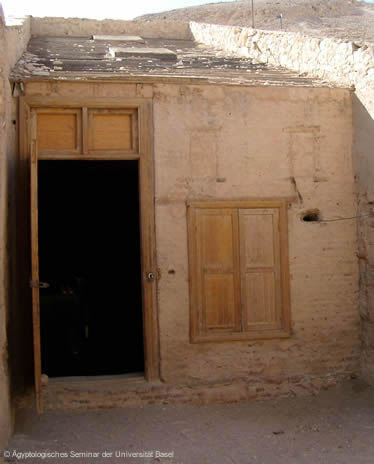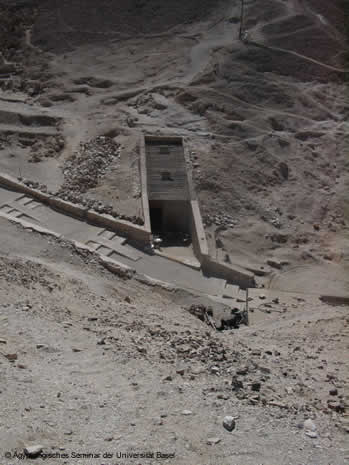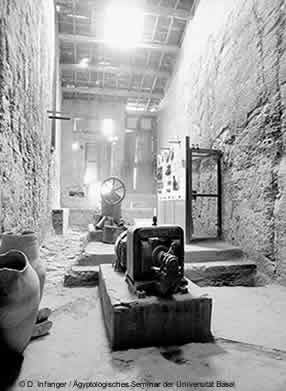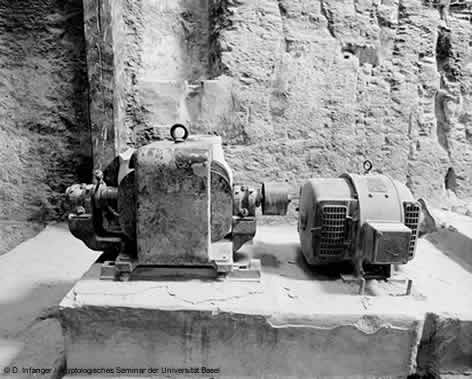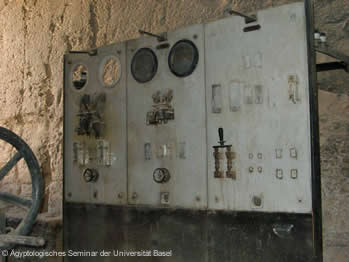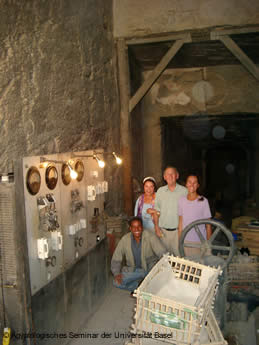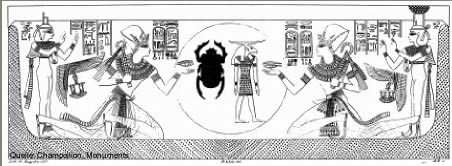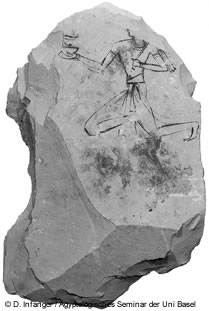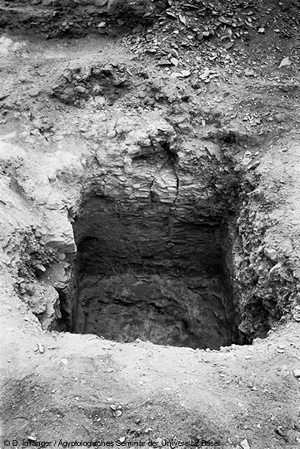Ramses X. KV 18: An unfinished tomb
The tomb of Ramses X in the Valley of the Kings of Thebes (Luxor) has not yet been published scientifically. The tomb was completely excavated and documented by the Basel team in two campaigns from 1998-2000. The publication of 2000 offers together with plans, drawings and photographs a description of the architecture, the decoration and the finds as well as a historical treatise on the person of Ramses X. Based on the diary of the necropolis workers it traces the events in the Valley of the Kings and gives a possible answer to the question where Ramses X. might actually have been buried.
Ramses X reigned only briefly (1107-1103 B.C.), his tomb remained unfinished, and the king was never buried in the tomb intended for him.
Over time, the rock tomb was largely filled with debris washed in by rainfall. A modern wall was built in the back part of the tomb by Howard Carter. In the front part, electric apparatuses were installed at the beginning of the 20th century, which provided some tombs of the Valley of the Kings with artificial light for the first time.
In the tomb, which is not accessible to tourists, the modern wall, which was located in the passage to Corridor C, was removed in 1998/1999. The backfill behind it, consisting of 30 alluvial layers, was excavated down to a profile consisting of 22 layers. It was found that the tomb remained unfinished and ended with Corridor C, in which the incompletely excavated rock rises in steps. The findings allow conclusions to be drawn about the working method.
Electricity for the Valley of the Kings: Howard Carter's power plant
A special feature of the tomb of Ramses X is the electrical apparatus installed under the supervision of Howard Carter. For the first time, they made it possible to illuminate the pharaonic tombs in the Valley of the Kings with artificial light. This was a huge step forward, not only for tourism, which was already booming at the time, but also for Egyptology, as electric lighting had played a significant role in the discovery of Tutankhamun's tomb in 1922 (as can be read in Howard Carter's report).
The electrical installations were examined and partially completed by an electrical engineer during the 2001/2002 campaign. Here is the summary report by Dr. Erwin Alzinger:
"For the illumination of six tombs in the Valley of the Kings already in 1902 a small power station was installed in the unfinished tomb of Ramses X. (KV 18) was installed. This equipment was designed by engineer M. Zimmermann and supplied by AEG Berlin. In 1925, Howard Carter made an effort to improve the electrical system. However, the renovation took until about 1936, when the switchboard for parallel operation of two generators, which still exists today, was supplied by Thomas Cook & Son in Cairo. This installation was in operation until about 1972. Since that time, many components have been removed. The remaining parts were registered and described. The control panel could already be partially restored." (Figs. 5-8.)
Due to the operation of the generators, the walls in Corridor A were heavily soiled. The architrave above the entrance was also affected. Cleaning by restorer Erico Peintner revealed the original colors (Fig. 9). The scene shows the sun disk with the depiction of scarab and ram-headed god, flanked by one figure each of the kneeling king and the standing goddesses Isis (left) and Nephthys (right). The image below shows an old redrawing of the motif (Fig. 10).
The embalming cache Tutankhamun KV 54
Through our excavation we were able to relocate the so-called embalming cache Tutankhamun, which is a shaft a little more than one meter deep, which contained objects of the famous king. This embalming cache of Tutankhamun is located about 110 meters from his tomb (KV 62) and a good 21 meters from the entrance to the tomb of Ramesses X. The cache was used for the burial of the famous king. In it, after the burial of the king and after the closing of the tomb, objects were disposed of in a reverent way, which had been used during the burial rites. The embalming cache of Tutankhamun was discovered and identified in 1907, but later buried again, so that the exact location was no longer known.
During the excavations in the vicinity of the tomb of Ramses X, on the one hand, a collection of workers' huts were found. These workers ' huts, which had remained undiscovered so far, yielded interesting information about the kind of "habitation" of the Valley of the Kings. On the other hand, fragments and objects of the burial equipment of Sethos I were found.
During the reign of Ramses X.
Ramses X. (1107-1103 B.C.), probably a son of Ramses IX, married to his sister or half-sister Titi - holder of tomb QV 52 in the Valley of the Queens - is hardly tangible to us as a historical personality. He reigned only briefly and left few monuments, which do not give any information about his politics. In his titulary, he refers to himself as "the one whose (desire for) world order is realized," from which perhaps the need for a stable policy may be inferred.
Although there are no monuments to the reign of the king himself, the diary of the necropolis workers of Deir el-Medineh from the 3rd year of Ramesses X. (Pap. Turin Cat. 18) provides us with some information. (Pap. Turin Cat. 1898) gives us a vivid picture. This diary shows that in the last year of the king hardly any work was done on his tomb (only on 37 days out of 212 recorded), which explains the little advanced state of the tomb. A main problem is the non-functioning supply of food to the workers and the dispute about competences, which culminates in the "class warfare" exclamation: "Let the vizier carry the clothes of king Ramses IX and the cedar woods (but himself)!" and the summoning of the whole crew before the high priest of Amun and the officials of the city of Thebes. Other days without work occur due to the celebration of religious festivals, work on private graves, and his own efforts to obtain food.
The definite finding in KV 18, where Rameses X was never buried, furthermore the absence of the king's mummy and generally of any grave goods from a burial of the king raise the question of the place and kind of the burial of Rameses X. This question also arises for Rameses VIII, who was buried in a private tomb. It also arises for Ramesses VIII and Ramesses XI, while Ramesses IX and probably also Ramesses VII were buried regularly in the Valley of the Kings. A tomb of Ramesses VIII has not been found in the Valley of the Kings so far, also objects of the tomb equipment or the king's mummy are not known. The tomb of Ramses XI was abandoned by the king himself in favor of a burial at another place. Since the tombs of the Valley of the Kings were cleared by the state during the 21st/22nd Dynasty in order to get access to the precious metals of the burial treasures, and since the location of the last royal tombs built here was still known at that time - the tombs of Ramesses VII and Ramesses IX were indeed cleared - the burials of Ramesses VIII, X and XI were most probably never located in the Valley of the Kings. Numerous indications suggest that (like Ramesses VIII and Ramesses XI) Ramesses X was also buried in a small chamber tomb in the Ramesside residence, the Ramesses City in the eastern delta (Qantir). As a hypothetical sketch of the historical development it follows: 1128 Ramses VIII dies after only one year of reign. For his burial, in view of the lack of possibility for burial in the Valley of the Kings, an emergency tomb is erected between the palace district and the main temple in the city of Rameses, which in turn may have been based on predecessors in the eastern delta. Ramses IX had a regular royal tomb built in the Valley of the Kings during his 19-year reign, while upon the death of Ramses X after a short reign and in view of possible domestic political problems, again the Valley of the Kings was out of the question for a burial and a second emergency tomb would have been built next to the one of Ramses VIII in Per-Ramses. Rameses XI, on the other hand, after abandoning his Theban tomb, would have deliberately opted for a burial in the city of Rameses and built here a (presumptively larger and richer) tomb next to the two preceding ones. The kings residing in Tanis would then have consciously referred to this late Ramesside tomb.

Publications on this topic
- The Tomb of Ramses X. (KV 18), ed. by Hanna Jenni. With contributions by Andreas Dorn, Hanna Jenni, Barbara Lüscher, Elina Paulin-Grothe, Thomas Schneider (Aegyptiaca Helvetica [AH], vol. 16), Basel: Schwabe 2000.
Together with plans, drawings, and photographs, the book offers a description of the architecture, decoration, and finds as well as a historical treatise on the person of Ramses X., which on the basis of the diary of the necropolis workers traces the events in the Valley of the Kings and gives a possible answer to the question, where Ramses X. could have been actually buried.
- E. Peintner, Uncovering and Conservation in Corridor A of the Tomb of Ramses X, 13-15,
- J. Horn / R. O. De Keersmaecker, Visitor Inscriptions in Corridor A of the Tomb of Ramses' X., 17-49,
- E. Alzinger, The Electrical Installations in Corridor A of the Tomb of Ramses' X., 51-53,
- A. Dorn / E. Paulin-Grothe, Excavations in the Valley of the Kings 1998-2008: Excavation Areas and Traces of Earlier Excavators, 55-65,
in: Zur modernen Geschichte des Tals der Könige. Conference in Basel, September 1, 2007, with contributions on the tomb of Ramses X. (KV 18) and on finds from modern times, ed. by Hanna Jenni (Aegyptiaca Helvetica [AH] 25), Basel: Schwabe 2015.
A completely nondescript tomb, unfinished, filthy, devoid of gold and mummy, and disguised with modern equipment, has proven - with the inclusion of its surroundings and consistent exploration - to be a rich historical source.
Team MISR
Quick Links

